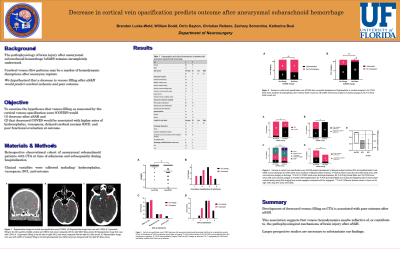Prediction of Delayed Cerebral Ischemia following Subarachnoid Hemorrhage: Utility of Cortical Vein Opacification Scores
Prediction of Delayed Cerebral Ischemia Following Subarachnoid Hemorrhage: Utility of Cortical Vein Opacification Scores
Friday, April 21, 2023


Brandon P. Lucke-Wold, MD, PhD
Resident
University of Florida
Gainesville, Florida, United States
ePoster Presenter(s)
Introduction: The pathophysiology of brain injury after aneurysmal subarachnoid hemorrhage (aSAH) remains incompletely understood. Cerebral venous flow patterns may be a marker of hemodynamic disruptions after aneurysm rupture. We hypothesized that decrease in venous filling after aSAH would predict cerebral ischemia and poor outcome.
Methods: In this retrospective observational cohort study of consecutive aSAH patients admitted to our tertiary care center between 2016–2018, we measured the cortical venous opacification score (COVES) at admission and subsequent computed tomography angiography (CTA). We collected clinical variables and compared hydrocephalus, vasospasm, delayed cerebral ischemia (DCI), and outcome at discharge in patients with decrease in COVES to patients with stable COVES.
Results: A total of 22 patients were included in the analysis. COVES decreased from 1st CTA to 2nd CTA in 11 (50%) patients, by an average of 1.1 points (p = 0.01). Patients whose COVES decreased between admission to follow-up imaging were more likely to develop DCI (58% vs 0%, p = 0.03) and have a poor outcome at discharge (100% vs 55%, p = 0.03) compared to patients who had no change in COVES. aSAH severity was not associated with initial COVES, and there was no association between change in COVES and development of hydrocephalus or vasospasm.
Conclusion : Development of decreased venous filling on CTA is associated with poor outcome after aSAH. This association suggests that venous hemodynamics may be reflective of or contribute to the pathophysiological mechanisms of brain injury after aSAH. Larger prospective studies are necessary to substantiate our findings.
Methods: In this retrospective observational cohort study of consecutive aSAH patients admitted to our tertiary care center between 2016–2018, we measured the cortical venous opacification score (COVES) at admission and subsequent computed tomography angiography (CTA). We collected clinical variables and compared hydrocephalus, vasospasm, delayed cerebral ischemia (DCI), and outcome at discharge in patients with decrease in COVES to patients with stable COVES.
Results: A total of 22 patients were included in the analysis. COVES decreased from 1st CTA to 2nd CTA in 11 (50%) patients, by an average of 1.1 points (p = 0.01). Patients whose COVES decreased between admission to follow-up imaging were more likely to develop DCI (58% vs 0%, p = 0.03) and have a poor outcome at discharge (100% vs 55%, p = 0.03) compared to patients who had no change in COVES. aSAH severity was not associated with initial COVES, and there was no association between change in COVES and development of hydrocephalus or vasospasm.
Conclusion : Development of decreased venous filling on CTA is associated with poor outcome after aSAH. This association suggests that venous hemodynamics may be reflective of or contribute to the pathophysiological mechanisms of brain injury after aSAH. Larger prospective studies are necessary to substantiate our findings.
